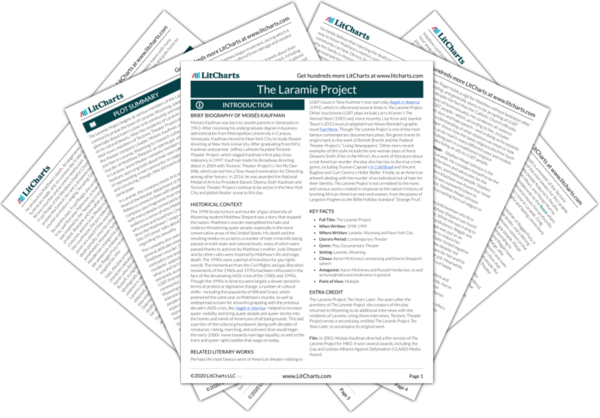Summary
Analysis
Aaron Kreifels describes finding Matthew Shepard tied to the fence where Aaron McKinney and Russell Henderson left him to die. Aaron Kreifels had gone for a bike ride the evening after Matthew’s attack. Not really knowing the way, Aaron picked directions at random. In retrospect, he thinks that God was guiding him to Matthew. Aaron kept riding and eventually fell off his bike. As he was brushing himself off, he noticed what he thought was a scarecrow tied to a fence. Aaron approached it and realized it was a person—Matthew. Aaron ran to the nearest house and called the police.
Aaron’s sense that God was leading him to Matthew shows that Aaron understands God to be a compassionate figure who would not punish Matthew for his sexuality. Aaron’s version of religion seems to help him process his proximity to such horrific violence. Notably, the playwrights do not state Aaron’s religious denomination, suggesting that it’s not the congregation itself that matters, but Aaron’s own vision of God.
Themes
Officer Reggie Fluty takes the floor, explaining how she was the one who responded to the call. Reggie ran over and saw that Matthew Shepard was tied to the fence, covered in blood, and was barely breathing. The only place Matthew did not have blood on his head was below his eyes, where he appeared to have been crying. Reggie noticed that Matthew had a severe head wound.
Reggie Fluty, whose story the playwrights follow throughout the play, first appears as she describes responding to Aaron Kreifels’ call. Reggie’s attention to blood in this description both emphasizes the profound violence Matthew endured and foreshadows Reggie’s HIV exposure.
Themes
Dr. Cantway, the emergency room doctor the night Matthew Shepard was brought in, describes how he had not seen a patient in such bad shape in a long time—not in the rural Laramie hospital, anyway. Dr. Cantway said that usually those kinds of severe injuries are the result of car crashes, not beatings. Aaron Kreifels begins to talk again, describing how he waited with Matthew for the ambulance to arrive and tried to wake him up.
Like Reggie’s descriptions of Matthew’s blood, Dr. Cantway’s discussion of the severity of Matthew’s injuries highlights the intensity of the violence that Matthew suffered. Matthew’s attack provides a reference point of extreme violence that contextualizes smaller incidents or fantasies of violence in the play.
Themes
Reggie Fluty resumes talking about how Matthew Shepard was bound to the fence tightly with white rope, and notes that his shoes were missing. Reggie struggled to release Matthew from the fence without hurting him further. Doctor Cantway speaks again, talking about how he hoped it was not a Laramie resident that hurt Matthew like that. Reggie then describes how Matthew stopped breathing briefly when they cut him off the fence and only breathed again when he was rolled onto his back. The emergency medical services drove him in an ambulance to the emergency room.
Dr. Cantway’s hope that Matthew was attacked and murdered by someone not from Laramie reflects a desire that Laramie residents frequently articulate to distance themselves and their town from the crime. These residents, who often are not people on the margins of Laramie society, have an image of their community as more tolerant and open than it actually is, an image that is challenged in the aftermath of the murder.
Themes
Get the entire The Laramie Project LitChart as a printable PDF.

Dr. Cantway notes that, strangely, Aaron McKinney came into the emergency room for an unrelated problem just before they brought in Matthew Shepard, and Dr. Cantway was helping Aaron just before he treated Matthew. Dr. Cantway says that, soon after seeing Matthew, they called in specialists from farther away, knowing Matthew needed special care. Reggie Fluty remembers seeing a picture of Matthew a few days after responding to the call and thinking she would not have recognized him. Dr. Cantway closes Act One by meditating on the coincidence that he treated both Aaron and Matthew, who were both “kids.” Dr. Cantway wonders if God feels like he did that night: a profound compassion for both of his “kids” and their bodies and souls.
As Dr. Cantway talks about treating both Matthew and Aaron at the same time without realizing it, he compares his compassion for both young men to what he believes God must feel for all people. Dr. Cantway’s comments speak to his own faith and the profound religious presence in Laramie. Dr. Cantway’s view also suggests that having compassion for everyone, even people who have done horrible things, is the moral way of engaging with painful human conflict. The playwrights explore this and other versions of morality throughout the play.
Themes












